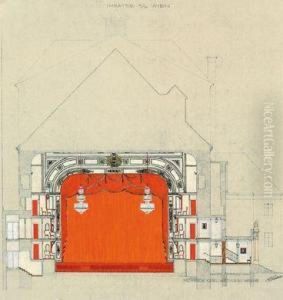Carl Witzmann Paintings
Carl Witzmann, born in 1883 in Vienna, Austria, was an influential architect whose work significantly contributed to the architectural landscape of early 20th century Vienna. His career spanned over several decades, during which he became known for his distinctive approach to design, blending traditional forms with emerging modernist ideas. Witzmann's education and early career were deeply rooted in the rich cultural and artistic environment of Vienna, a city that was a hub for innovation in art, architecture, and design during his formative years.
Witzmann's architectural style evolved over time, initially influenced by the Art Nouveau movement and later incorporating elements of functionalism and new objectivity, reflecting the broader shifts in European architecture of the period. His works include a variety of building types, from residential projects to significant public buildings, each demonstrating his ability to adapt and innovate within the architectural vocabulary of his time.
Throughout his career, Witzmann was actively involved in the architectural community in Vienna, participating in various exhibitions and competitions that helped to establish his reputation as a leading architect of his generation. Despite the challenges posed by the World Wars and the changing political landscape of Europe in the first half of the 20th century, he continued to produce work that was both relevant and respected.
Carl Witzmann's contributions to architecture were recognized by his peers and by future generations, marking him as a key figure in the transition from traditional to modern architectural practices in Austria. He passed away in 1952, leaving behind a legacy of innovation and excellence in design that continues to influence architects and scholars.

